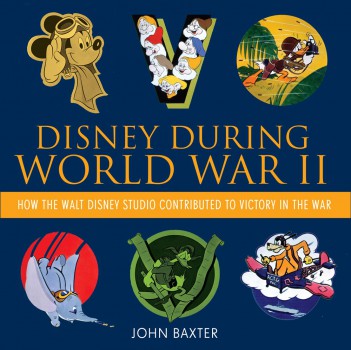“Disney During World War II” Book Review
This new book, Disney During World War II, is written by John Baxter. He has a history of writing about film, but this is his first book about Disney. The book begins with acknowledgments, where he thanks members of the Walt Disney Archives, Disney Photo Library and the Animation Research Library. He also thanks Neil Gabler and Dr. Richard Shale for their earlier work on this topic, giving credit where credit is due.
It paints a picture of Walt that wasn't as clear in previous books that I've read. He comes off as selfless, not profiting from the war and only charging the government what the films cost to produce. In addition, his decision to focus most of the studio for government use meant he could keep many of his employees (1/3) off the front lines since they were already serving their country by producing these propaganda films. It was Walt who approached the government, not the other way around, and it's clear that he was doing everything he could to get his team through this difficult time where Disney films and shorts were losing money without an international market to release them to. It's the story of a man doing whatever it takes to serve his country and keep his people employed.
The book is divided into five sections after a brief history of how Walt entered the war. They are The Training Films, Propaganda, The Entertainment Shorts, Military Insignia and lastly Gremlins - The Feature That Might Have Been. In the three sections devoted to the film content produced, Baxter gives a description of each piece and some of the history behind them. I was unaware how critical Ub Iwerks was during these films, something that is often not listed when you hear about his contributions to Disney. I knew that Walt was unhappy about sacrificing quality for these films, but many of the lessons learned were applied to the educational episodes of the Disneyland series a decade later.
In the Propaganda section, Baxter points out all of the reused animation and where it comes from. To make these shorts on a budget, they would often reuse cells from an earlier production over new backgrounds. They were sometimes even able to reuse voice tracks from earlier shorts so they didn't have to pay a voice actor to record the lines. The South American films are briefly mentioned in this section since they started as an effort to strengthen the relationship between North and South America during the war. There was even some controversy from the public over Walt being paid for the films, so Reader's Digest stepped in to fund some of the films (most likely receiving money from the government in return). Victory Through Air Power is picked apart in this section as well, put in the context of not knowing the outcome of the war compared to the strategies that won.
The Military Insignia section is most impressive. I was unaware that Walt established the unit himself and offered free insignia to the U.S. Armed Forces and allies by request. The unit produced nearly 1,300 insignia (and there were more requests that went unfilled when the war ended). Roy Williams, of The Mickey Mouse Club fame, was one of the members of this group. Donald Duck was the most requested character, but the artists often pulled obscure characters from Silly Symphonies to get more diversity amongst the produced insignia. There are plenty of pictures in this section with images of some of the artwork created.
The section that most excited me was Germlins. I was unfamiliar with this project until Dark Horse reproduced the original book by Roald Dahl in 2006, but there was still little published about the feature film version. This section is actually quite large and runs from page 134 to 171. It's an incredibly detailed account of the back-and-forth between Walt Disney and Roald Dahl and reading it draws some parallels to Saving Mr. Banks (including disputes over character design and full script approval). The film was originally conceived as a combination live-action/animation similar to Song of the South, but Walt changed his mind and decided it should be all animation. An overview of the story treatments are given, including full storyboards of the project reworked as a short not long before Walt decided to cancel the project all together.
Other books have certainly chronicled the World War II era of Disney history before, but none have done as thorough of a job as John Baxter's Disney During World War II. In addition to being a must read for every Disney history buff, it is also a must read for World War II enthusiasts. It makes it clear that the Walt Disney Company served the war effort more selflessly than any other company at the time and lists all of the accomplishments made on the war effort as a direct result of Disney's influence.







